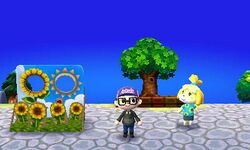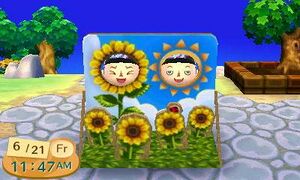Summer Solstice
| ||||||
 | ||||||
| Occurrence | ||||||
|---|---|---|---|---|---|---|
| June 21st | ||||||
| Time | All day | |||||
| Host | Tortimer[nb 1] Isabelle[nb 2] | |||||
| Main appearances | ||||||
|
| ||||||
| Other appearances | ||||||
Names in other languages
Unknown
Unknown Unknown Unknown
Unknown
Unknown Unknown Unknown
Unknown Unknown Unknown Unknown | ||||||
The Summer Solstice, also known as Midsummer's Day, is an event in the Animal Crossing series, coinciding with the first day of summer – June 21st.
In Animal Crossing: City Folk
In City Folk, the Summer Solstice is a European-exclusive event, referred to as Midsummer's Day, that takes place on the 21st of June.
Because this day is supposedly the longest day of the year, the sun sets later on this day than any other day. If the player talks to Tortimer outside the Town Hall, they will receive an Espresso Maker.
In Animal Crossing: New Leaf
In New Leaf, the event takes place in the player's town on June 21, the day when the sun is visible throughout the entire day, even at midnight. Despite this, bugs, fish, and sea creatures still appear at their usual times. When the summer solstice occurs, the town holds a celebration, which is marked by a cut out board featuring a sun and a sunflower. If the player speaks with Isabelle, who is located in the Event Plaza, she will give them a pair of Ladder Shades. If a Bug Off occurs on the solstice, Isabelle will be located in front of the Town Hall instead.
Real Life Definition
In actuality, the summer solstice is a phenomenon that occurs when the tilt of a planet's semi-axis, in either the northern or the southern hemisphere, is most inclined toward the star (in Earth's case, the Sun) that it orbits. Earth's maximum axial tilt toward the sun is 23° 26'. This happens twice each year - once for each hemisphere; during these times, the sun reaches its highest position in the sky as seen from the north or the south pole. However, what is seen in Animal Crossing: New Leaf is actually known in the real world as a "polar day," a day on which the sun is visible for more than 24 hours. The event takes place in the Arctic Circle and Antarctic Circle on the days surrounding the summer solstice.
| ||||||||||||||||||||||||||||||||||||||
Cite error: <ref> tags exist for a group named "nb", but no corresponding <references group="nb"/> tag was found
